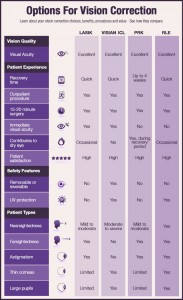
Vision Correction Treatment Options at GWSVI
Vision Correction Treatment Comparison Chart
Custom All Laser LASIK and PRK
LASIK is an acronym for Laser Assisted In-Situ Keratomileusis, which means “to reshape the cornea by using a laser.” The procedure uses an excimer laser to reshape the outer layer of the eye known as the cornea, thereby bending the light entering the eye to focus on the retina and produce a clear image. The difference between PRK and LASIK Surgery is that PRK treats the exterior of the eye, reshaping the outside surface while LASIK Eye Surgery reshapes the cornea after a thin flap has been created on the surface of the eye. Custom all laser LASIK/PRK is one of the most exciting breakthroughs in laser eye surgery. With no mechanical incisions required, our All-Laser LASIK procedure is less invasive and offers patients unprecedented safety & precision.
The ability to control higher-order aberrations and to reduce or eliminate any potential increase in these distortions makes customized laser vision correction a particularly desirable procedure. The improved software programs for All Laser Custom procedures have improved upon the excellent visual results that are currently available. It not only corrects the error(s) from the eyeglass prescription, but also corrects the higher-order aberrations that can lead to the other 10% to 15% of visual distortions affecting quality of vision.
ICL – IMPLANTABLE COLLAMER LENS
What is the Visian ICL? While you may have heard it called the Implantable Contact Lens, the Visian ICL officially stands for Implantable Collamer Lens. When implanted in the eye in front of the natural lens, it acts exactly like a contact lens, except it is permanently placed inside your eye. Currently the lens is used to treat nearsightedness or myopia, improving vision without glasses or contact lenses.
When an eye is nearsighted, light entering the eye does not reach the retina, because the lens or cornea bends the light too much or the eye is too long. As a result the image is blurry and some type of vision correction is required to see clearly. The ICL implanted in the eye focuses the light entering the eye on the retina so that the image received by the brain is clear.
To begin the ICL procedure, the surgeon creates a small incision to insert a folded lens in the eye. Once the lens is positioned, its corners are tucked underneath the iris or colored part of the eye. Anesthetizing eye drops are used so there is no discomfort and most patients begin to see clearly within a few minutes following the procedure.
RLE – Refractive Lens Exchange
Vision correction procedures such as LASIK correct vision by changing the shape of the cornea. RLE, on the other hand, does not change the shape of the cornea, but rather changes the lens in your eye. As light enters the eye it is first focused by the cornea and then by the lens. RLE removes the focusing lens in the eye, the crystalline lends, and replaces it with an artificial lens of a different power. This new lens allows light to better focus on the retina (the seeing membrane in the back of the eye). This procedure is very similar to cataract surgery.
RLE can treat a greater range of nearsightedness and farsightedness than LASIK. This is due to the fact that no tissue is removed and the shape of the cornea is not changed; as is inherent in many laser vision correction procedures. Many patients have been told that LASIK is not a good option due to too large of a correction; these individuals may be excellent candidates for RLE. Presbyopia (near vision) may also be corrected due to the various lens options available.